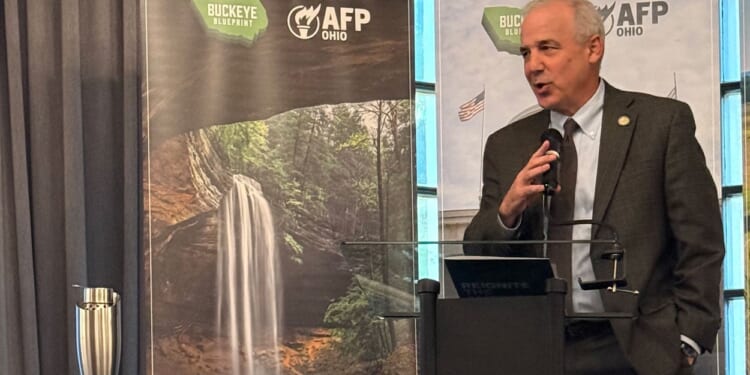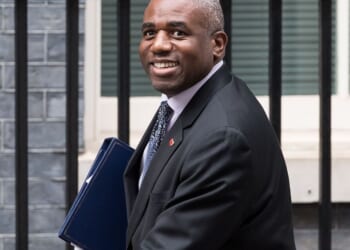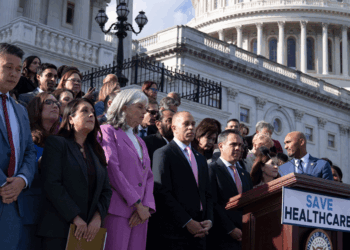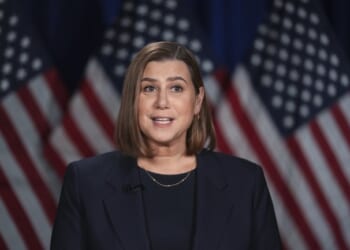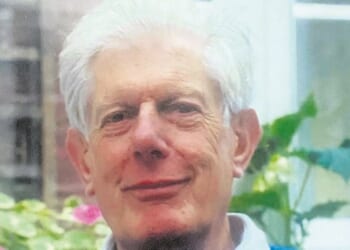COLUMBUS, Ohio—Ohio is making changes in many ways, especially when it comes to opportunity. That’s the sense one gets from Republican Speaker Matt Huffman of the Ohio General Assembly. Huffman was the recipient of the 2025 Taxpayer Torch Award from Americans for Prosperity’s Ohio chapter, with The Daily Signal present.
“A few years ago, we set out to raise the caliber of legislators in Ohio—believing that strong, principled lawmakers would elevate the quality of leadership statewide. Today, that vision is becoming reality,” Donovan O’Neil, the state director for AFP-Ohio, told The Daily Signal on Tuesday. “The Taxpayer Torch Award celebrates bold, conservative leadership—those who stand firm for reform and deliver real results. It honors the policymakers who light the way toward a freer, more prosperous Ohio.”
Before accepting his award, Huffman spoke with The Daily Signal. Crediting “a number of the things that we’ve done,” the speaker mentioned how they “are on the cusp of” and beyond when it comes to opportunities for the Buckeye State. This includes technology, but also “regulation that makes sense,” which could help farmers as well as those in the oil and gas industry to “be more productive.”
Huffman didn’t merely praise how Ohio has “always had cheap water, cheap electricity, and good geography,” but also pointed to the role of House Bill 15, a landmark energy reform law that went into effect in August. As the speaker described it, the law “has created a free marketplace for energy.” He further mentioned during his acceptance speech how Ohio now has “free market energy and people can build and design their own power plants.”
The speaker also managed to break down tax reform in an appealing and easy-to-understand way, explaining how “the folks who are coming and working on these things,” like data centers, “have a lower flat tax rate.” Ohio is actually growing, rather than losing population, especially with the 25-44 age bracket, which Huffman believes has to do with lower taxes, and is why he’s “pretty optimistic.”
Although there have been recent successes, Huffman also pointed to getting rid of the estate taxes in 2013 as “one of the reasons why we’re successful.”
“We’ve gone from 9% to 2.75% in income tax,” Huffman shared, offering another example of how a lower tax rate has helped Ohio.
As Huffman would delve into during his speech, the result of such opportunities is transformation. “Ohio, and I think in some ways, the Ohio Republican Party has been on a transformational journey, really, since about the late 1970s and into the 1980s when we were a state that increased taxes because we saw what we wanted to do,” he offered. By the 1990s, however, taxes were “really crushing the state in terms of our economic output and people leaving.”
“The Republican Party began to realize that that was the problem and our mission was not, ‘How will we pay for more things, but how do we allow the free market to work? How do we let individuals create more things?’” Huffman continued. To applause, he described the flat tax achieved in the budget as “monumental,” especially “given where we were.” He later referred to the budget as “the most consequential budget that we have.”
Huffman also pointed out the growth of data centers. This is in addition to Intel’s promise to build a plant in Ohio that looks to be back on track after the Trump administration signed a deal with Intel in August. After Sen. Bernie Moreno, R-Ohio, sought answers about Intel’s plans, the company indicated it remains committed to the Ohio plant.
Moreno also recently shared over X more news about other companies, in this case Whirlpool, investing in Ohio. The senator credited President Donald Trump.
There’s also the matter of furthering Trump’s vision, with AFP-Ohio’s O’Neil seeing a parallel between the 2024 elections at the federal level and in Ohio. “Broadly speaking, what the Republican majority in the statehouse is doing closely mirrors the priorities of the new Republican majority elected in 2024,” he shared.
O’Neil didn’t merely praise how “Ohio is winning,” with “lower taxes, less regulation, and greater freedom for parents to choose the best education for their children,” he also applied it to efforts at the federal level.
“The Ohio General Assembly has already delivered on much of that vision. In a similar way, the Trump administration, thanks to the work of Speaker [Mike] Johnson and Leader [John] Thune, advanced prosperity by signing the Working Family Tax Cuts, making permanent the middle-class tax relief from 2017,” O’Neil continued. “Those efforts, combined with ongoing work to cut red tape and rein in federal spending, are moving us in the right direction.”
Huffman similarly praised the General Assembly. He closed his speech by offering that “the Ohio House Republican caucus this year deserves this award because they’ve really come together and shown that we are a conservative, free market, free thinking group of people to do this.”
Others have also been promoting economic successes in Ohio, especially as it applies to the “One Big, Beautiful Bill.” Before Huffman took to the podium to accept his award, a video montage of previous winners appeared, including Sen. Jon Husted, R-Ohio. He called to mind key provisions of the One Big, Beautiful Bill, including no taxes on tips and no taxes on overtime.
“The passage of the bill brings a degree of certainty and clarity to federal policy, which is a significant positive. Businesses consistently emphasize that predictability is key to effective planning,” Huffman also shared about the One Big, Beautiful Bill. “While the bill includes tax cuts and a range of other provisions, the most important aspect may be that the federal government has taken action. That, in itself, sends a strong signal of direction and stability.”
O’Neil left the conversation on a practical but also optimistic note: “At both the state and federal levels, there’s still more work to be done—but our grassroots activists remain on the front lines, celebrating and championing good public policy and the principled leaders driving these reforms.”

